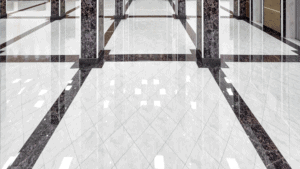Marble Restoration Services
Marble floors are an investment that is worth protecting.
They bring beauty and elegance to your home while enhancing its value.
After time stains and etch marks will start to appear if regular maintenance is not done.
If marble restoration is needed it will require diamond honing and re-polishing to bring back the marble to its original condition.
Marble/Stone Restoration
Marble Restoration is one way of restoring it to its original condition.
You should note that polishing marble without honing will not remove the undesired etch marks and scratches.
Most people assume or believe that honing and polishing refers to the same thing during the marble restoration process. However, there are some minor differences.
A polished finish leaves the floor looking shiny and glossy.
On the other hand, a honed finish is not as shiny or reflective as a polished one.
Most homeowners tend to believe that shine present on marble floors is achieved through the application of certain chemicals.
However, marble polishing is a process that utilizes physical techniques, to restore the shine.
There are certain rare instances when chemicals are used during the polishing, especially when the marble is etched.
The shiny polish is a result of high friction using stone polishing machines at the factory before it is shipped to the customer.
Always ensure that marble polishing or any form of restoration is done by JK marble maintenance. Avoid shortcuts, since they might lead to permanent damage to your floor.
Restoring Marble Floors
Marble polishing is a very crucial process, during marble restoration.
As previously noted, polishing without honing does not remove accumulated scratches or etch marks.
Honing comes before polishing. Honing is a complex process that involves the restoration of marble floors, using diamond encrusted pads to hone or scratch the marble surface.

The honing process starts with the use of grit diamond pads, which remove a marble layer.
The process is then continued using diamond pads until the surface attains the desired polished finish.
Once the marble attains some reflective properties, the next step is polishing, using polishing powders.
The last step is more of a chemical process, as opposed to mechanical polishing.
This process should only be undertaken after honing.
Etch marks on marble occur when acidic substances come into contact with marble surfaces and then reacting with the calcium present in the marble.
If the etches are not severe, a simple polishing using polishing powder is enough to remove them. However, if the etch marks are too deep, the floors must be honed and then polished.
If you have marble floors, whether at your place of business or at home, then they will require polishing at some point.
If the floors have stayed for many years without any form of maintenance, then they will first have to be honed, before they can be polished.
Polishing marble is a multi-step process, which can take several days to accomplish, especially if the floor is large.
TILE & GROUT CLEANING
Tiles are a popular flooring material. They come in different patterns and color combinations.
Despite their beauty and durability, tiles need regular care and cleaning. Here are some tile cleaning tips to consider:
Vacuum or sweep your tile floors, at least 3 times per week.
Grit and sand can scratch and dull the surface.
Mix hot water with a mild detergent and apply it to the floor using a chamois mop or rag. Instead of using a sponge mop.
Pour the cleaning solution after a few mops and replace it with a clean one. So that you don’t leave dirt on the floor.
If you end up with a cloudy dirt film on the floor, clean it using an all-purpose cleaner.
Ensure it is non-abrasive so that it doesn’t scratch the floor.
You can prepare your own cleaner by mixing vinegar with lemon juice in hot water(note do not use on marble).
Apply this cleaning solution to the floor, and then proceed to buff dry using a clean piece of cloth. You can also use a towel, which you can drag over the floor using your foot.
MARBLE STAIN REMOVAL
- Apply this solution directly to the stain, and allow it to stay overnight.
- Scrub it in the morning using a nylon brush.
- For stubborn stains, mix baking soda with water.
- Never use metallic brushes since they will scratch the floor.
- Proper cleaning of tiles will keep them in great condition for many years.
- For tea, juice or coffee stains, use hot water and detergent to clean the floor and then blot using hydrogen peroxide.
Marble restoration in the following city’s : Beverly Hills, Bel Aire, West Hollywood, Westwood, Santa Monice, Brentwood, Pacific Palisades, Hancock Park, Burbank, Toluca Lake, Studio City, Sherman Oaks, Beverly Park, Encino, Calabasas, Westlake Village, Agoura Hills, Porter Ranch Santa Clarita, Hidden Hills, Bell Canyon, Pasadena, La Canada
